|
| |
Other Minerals
|
We also export
other minerals including dolomite, talc, potassium feldspar, albite,
calcite, brucite, forsterite, lime, and all other minerals originated from
the northeastern part of China especially from the Liaoning Province.
|
|
1. Dolomite |
|
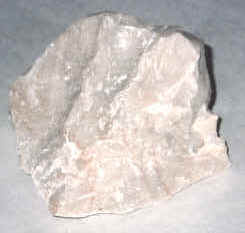
|
It is composed of calcium-magnesium carbonate. Molecular formula is CaMg(CO3)2often presents white or gray white color with glass glance, hardness is 3.5-4; brittle; specific gravity is 2.8-2.9. It is widely used as building material, chemical material, refractory, solvent etc.
Calcined dolomite, featured by low bulk density, low intensity, high chemical activity, being prone to hydrate and becoming Ca(OH)2 and Mg(OH)2, is excellent slagging agent in steel-making; sintered dolomite may be made into doloset which is used for mending the
linings of open hearth furnace and electric arc furnace as well as the major material for making tar pitch impregnated dolomite brick and dolomite-carbon brick.
|
|
MgO (%) |
CaO
(%) |
SiO2(%) |
Fe2O3(%) |
Size (mm) |
|
≥21 |
≥30 |
≤1.5 |
≤1.0 |
natural lumps |
|
|
2. Talc |
|
|
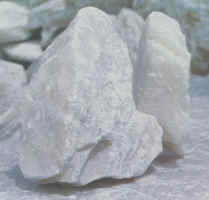 |
Talc is a mineral of magnesium silicate containing water, molecular formula is Mg3Si4O10(OH)2, presenting slight colors of whiteness, greenness, pink or gray, with glass glance; often forming a flaky or dense
aggregate; hardness is 1; specific gravity is 2.7-2.8; with a slippery and greasing feeling. It is widely used in fields of cosmetic, medicine, painting, paper making, ceramic, resin making etc.
|
|
Brand \ Specs |
SiO2 |
MgO |
Fe2O3 |
Whiteness(%) |
Size (mm) |
|
lump |
Haicheng No.1 |
≥60 |
≥30 |
≤0.3 |
≥92 |
15-200 |
|
Haicheng No.2 |
≥58 |
≥30 |
≤0.4 |
≥90 |
15-20 |
|
powder |
Haicheng No.1 |
≥60 |
≥30 |
≤0.3 |
≥90 |
passing through
325 mesh ≥98% |
|
Haicheng No.2 |
≥57 |
≥30 |
≤0.4 |
≥89 |
passing through
325 mesh ≥98% |
|
Micronized |
≥60 |
≥30 |
≤0.4 |
≥90 |
1,250-4,000 mesh |
|
|
3.
Potassium Feldspar |
|
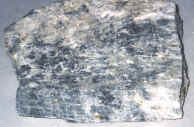
|
It is a silicate mineral rich in potassium, molecular formula is KAlSi3O8showing itself in gray-white color with glass glance; hardness is 6-6.5; specific gravity is 2.5-2.8. It is featured by low melting point, long time of
melting intervals and higher viscosity of the melt. It is widely used in glass, porcelain enamel, ceramic, abrasive, fertilizer and chemical industries.
|
|
K2O (%) |
Fe2O3(%) |
NaO(%) |
Size(mm) |
|
≥11 |
≤0.3 |
≤1 |
natural lumps |
|
|
4. Albite |
|
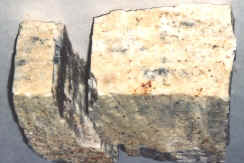
|
This is a silicate mineral rich in sodium, molecular formula is NaAlSi3O8, presenting gray, yellow gray or milk gray color; with glass glance; hardness is 6; specific gravity is 2.61-2.76. Mainly used in
glass, porcelain enamel and abrasive industries.
|
|
NaO
(%) |
Fe2O3(%) |
K2O
(%) |
Size (mm) |
|
≥11 |
≤0.3 |
≤1 |
natural lumps |
|
|
5. Calcite |
|
Calcite is one of very ordinary minerals, molecular formula is CaCO3, i.e. calcium carbonate; often shows itself in white or white gray color; with glass glance; hardness is 3; specific gravity is 2.6-2.8. It is widely used
in fields of chemical industry, paper-making industry, building and decorating materials and art carvings. |
|
CaO(%) |
MgO(%) |
SiO2(%) |
Fe2O3(%) |
Whiteness(%) |
Size (mm) |
|
≥54 |
≤0.5 |
≤0.5 |
≤0.1 |
≥92 |
natural lumps or powder |
|
|
6. Brucite |
|
Brucite is also called natural magnesium hydroxide, molecular formula is Mg(OH)2Theoretical contents are: MgO=69.0%, H2O=31.0%. Often shows itself in white or white gray color, glass glance can be seen on fresh crystal surface, cuts or fracture; transparent;
hardness is 2.5; specific gravity 2.3─2.6. Often presents a plate, fine flake, perfect round or abnormal grained-aggregate.
There are wide applications for brucite, it is not only a kind of high grade refractory materials but also the best material for making magnesium metal.
fibrous brucite,
due to its good fire retardancy, is ideal non-toxic, smokeless,
non-polluting, and adding in high temperature flame retardant; fibrous brucite can be also used as intensifying and reinforcing material, additive for making water-proof and fire-proof paper. crude brucite
can be used as the raw material for making nucleus reactor's protecting
material; it can be also used for soil improvement, making fertilizer and
regulating PH value of lakes; or naturally, it can be directly used as raw
material for making lightweight magnesium oxide, magnesium silicate, magnesia
cement, magnesium solder flux and handicrafts.
|
|
Item |
MgO(%) |
SiO2(%) |
CaO(%) |
Fe2O3(%) |
Al2O3(%) |
L.O.I(%) |
Size(mm) |
|
Typical
|
66.76 |
0.4 |
0.92 |
0.82 |
0.46 |
30.64 |
natural
lumps |
|
Guaranteed |
≥60 |
≤1.0 |
≤1.5 |
≤1.2 |
≤0.8 |
≤35 |
|
7. Forsterite |
|
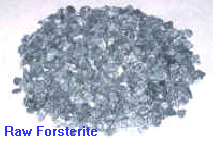
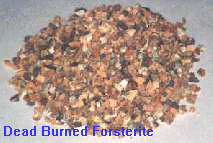 |
|
This is a kind of olivine family minerals, molecular formula is Mg2(SiO4) or 2MgO.SiO2,(shorted as M2S); its color is white, light yellow or light green; hardness is 6.5-7; density is 3.22-3.33g/cm3; lattice energy is as high as 17527.84J/mol; melting
point is 1890 °C. Its main applications are as molding sand, sandblast abrasive, flux and slag-making material in iron-melting blast furnace
as well as refractory materials in high temperature furnaces. |
|
Name / Specs |
MgO(%) |
SiO2(%) |
Al2O3(%) |
Fe2O3(%) |
CaO(%) |
L.O.I.(%) |
|
Raw Forsterite |
Typical
Value |
45.50 |
37.10 |
1.04 |
6.55 |
0.72 |
9.04 |
|
Dead Burned Forsterite |
49.70 |
41.80 |
0.40 |
7.42 |
0.23 |
0.30 |
|
8. Limestone |
|
The limestone is used
in steelmaking for removing sulfur and phosphorus from pig iron. It
is as flux for adjusting slag composition, alkalinity and viscosity
in steel and iron production. |
|
Name / Specs |
CaO(%) |
SiO2(%) |
MgO(%) |
Size, mm |
|
Lime |
50.5 - 51 |
1.2 - 1.3 |
3.5 - 4.0 |
0 - 5 or 5 - 50 |
|